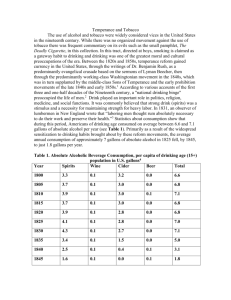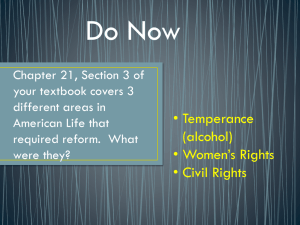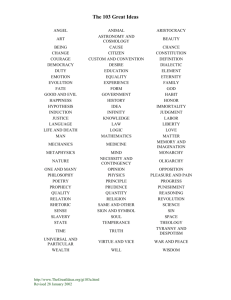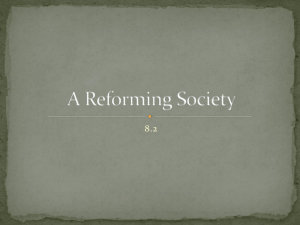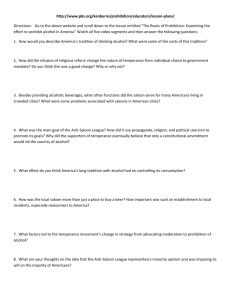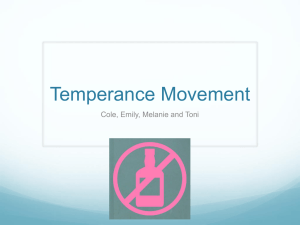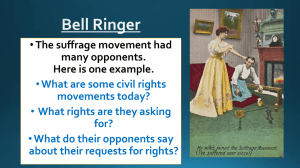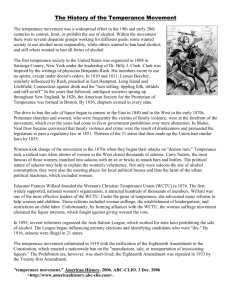Temperance Movement
advertisement
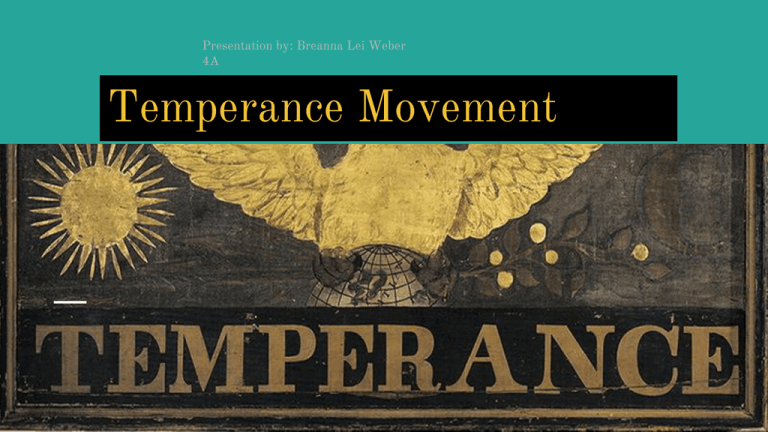
Presentation by: Breanna Lei Weber 4A Temperance Movement What is the Temperance Movement? Temperance: Moderate consumption of alcohol The Temperance Movement started in the early 1800’s and lasted to the early 1900’s. The movement prompted people to stop drinking alcohol and eventually give it up entirely. It even became the 18th amendment in 1920 to stop alcohol sales, distribution, and creation however was later repealed. Alcohol was considered better to drink than water which was contaminated. Many people before and during the revolution drank this beverage almost religiously, and so there would be people who would resist such a change. Workers would even drink while working, it would be consumed for any special occasion such as ceremonies, and sometimes expected with payment. This however sounds harmless to drink here and there however the people would drink excessively. Many people spoke out against drinking since it would cause problems. Many families became sickened by all the money being wasted on alcohol and many women even joined the movement due to being tired of their husbands spending an excessive amount. Business Owners chimed in since they needed men to run their machinery. It also caused chaos out in the streets such as drunken brawls. Second Great Awakening Small description: The Awakening started gaining momentum in the early nineteenth century, but was started in the late 1700’s. Such as the first it was a revival in religion. The Methodist preachers led this movement. This movement (SGA) made a large impact on the Temperance Movement. With the revival and returning to religion drinking excessively was frowned upon. Those who are religious tend to want to follow the rules and please their God. With want of becoming purer those who followed the movement would speak out and even quit drinking alcohol. Connection and Impact (SGA) Those who fell into the Second Great Awakening looked to become Christianized. In Christianity in is practically a sin to be inebriated. Therefore many religious leaders, such as preachers, would spread the message around. Due to this a majority of churches decided to “take up arms” if you will and join the Temperance Movement. With those churches and people reviving religion, and the Temperance Movement on foot many sought to stop alcohol in general and over all. “Do you not know that your body is a temple of the Holy Spirit, who is in you, whom you have received of God? . . . . Therefore honor God with your body” (1 Corinthians 6:19, NIV) “So whether you eat or drink or whatever you do, do it all for the glory of God” (1 Corinthians 10:31, NIV Alcoholism Alcoholism was a large problem in the 1800’s in American society. It affected the economy, families, and manufacturing. Thankfully however the Second Great Awakening led to the Temperance movement which would help monitor the money people would drink away. Not only with that but they even passed laws such as the Maine Law to regulate the consumption of alcohol by prohibiting the making and sales of it. Although the law didn’t work out as planned it still showed that people were giving effort to lower alcoholism. Also through their efforts they were able to decrease the amount per capita consumption of hard liquor.Considering that there was a law in effort to rid of alcohol it showed that alcoholism was indeed a large problem. Alcohol and problems stemming from it There were many problems that were caused due to Alcoholism such as, crime, disorder, poverty. and a negative effect on the economy. ➢ Alcohol was cheap, a gallon of whiskey was on average 25 cents. Having it be so cheap it was easy to obtain and become drunk. Men could spend all their wages on it leaving their families in deep poverty with little to no food. You could even argue that some children and women would have to work to feed themselves considering that their father would spend all his income on such a beverage. ➢ Leaving a negative effect on the economy many workers would show up to their work drunk which would affect the amount of things being manufactured. Not only would it slow down numbers it would also cause problems since working drunk could and most likely will cause accidents. Leaving the companies to have to pay for the damages, injuries, and possibly shutting down their business depending on the accident. Hence why business owners, religious or not, would join this movement so their business could effectively run. Problems continued... ➢ Going off on the business and economic standpoint, excessive drinking led to decreased labor efficiency. Once again hurting manufacturing and the economy. ➢ Drinking would cause problems with people’s families because some men would become violent and harm their wives and children. Without even laying a hand on them the men could harm them by drink the money away leaving their children and wives poor. Lastly it could even ruin the family's name and reputation leaving those affected by the person who excessively drinks being mocked and looked down upon. ➢ Drinking during this time led to gambling and prostitution. Already spending much on alcohol and losing to gambling would leave those who lost all their money to cause problems with their family, look for other means of employments, and sink into poverty. 1st half of notes (First hand out) ❖ Christianity was being mobilized due to the revival of religion. ❖ Many fell into the revival gaining more religious perspective. ❖ People wanted to live a purer life and so they would quit and speak out against drinking which was practically a sin to drink excessively. ❖ While this movement was already in place the Temperance Movement also began during this period which would be easy to connect to. ❖ With people following both movements alcohol was being protested through distribution, sales, and making. ❖ Alcohol was a large problem due to many seeking to even entirely abolish it. ❖ Alcoholism was indeed a large problem which caused many problems economically, family wise, crime, disorder, and poverty. ❖ Drinking excessively led to businesses having a low production rate. Spreading of the movement Going back to the Second Great Awakening many (mostly women) sought for a revival of religion and also to see alcohol removed hence the Temperance Movement. The Second Great Awakening “awoke” perhaps those being affected by alcohol. Of course not everyone sought to destroy it however with religion spreading more throughout the country, some places more than others, many people joined this movement to better their lives, those of fellow Christians, and over all heal the country of such an abomination. How widespread was it? And Where? Temperance was spread through mostly women and those who were part of the revival of religion. There were many groups/societies that were created to attack the drinking problems and hopefully destroy it. A society that was formed was formed in Boston in 1826 and was called the American Temperance society. Many in the north followed with Boston creating different societies such as that one. Those groups sent out pictures, pamphlets, and lecturers. Through this word could travel easily and so many were made aware of this. Leader of Temperance Movement There wasn’t a main character that led all these people to temperance. However certain influential voices and groups led this movement forward throughout the years. A few key people: ❏ Neal S. Dow/ Father of Prohibition: sponsored Maine Law in 1851 ❏ T.S. Arthur wrote “Ten nights in a barroom and What I saw there.” ❏ John B. Gough: temperance reformer and lecturer/ gave 9,000 lectures to 9 million people in the US and Europe. He also got 200,000 people to sign a pledge to stop drinking. ❏ Susan B. Anthony, Frances F. Willard, and Cary A Nation all tried to stop Reaction to new immigration and Anti- Catholic feeling ● They did not like immigrants for their free drinking habits. ● They wanted abolition rather than tolerance. ● The immigrants came from Ireland and Germany which are two countries known for their heavy drinking. The Irish are and were mostly Catholic. When they were told they could not drinking they took it in offense due to their religion. Successful? How so? Was the Temperance Movement successful? Overall it wasn’t as successful as they had hoped. The Maine Laws were a failure, campaigns led to restrict manufacture as well as sales, and the laws here overall completely ineffective. However they were successful in creating the American Temperance Society which caused thousands of other societies to be established and a growing effort to limit alcohol. Furthermore with the use of pictures and pamphlets reformers were successful in getting their point across. 2nd half of notes (second hand out) ★ The movement was national and international, and spread through lecturers, pamphlets, and pictures. ★ Susan B. Anthony, Frances F. Willard, Cary A Nation, Neal S. Dow, T.S. Arthur, John B. Gough, and other writers, government officials, and influential people over all led this movement. (Churches and societies took part too) ★ Many people felt ill towards the immigrants and Catholics. ★ The immigrants who came over were mostly Catholic and from heavy drinking countries. (Ireland and Germany) ★ The immigrants from there religiously drank and so refused to give up the Conclusion People internationally followed this movement for the better good of their society and selves. Whether religious or not many took part of the Temperance Movement. If simply people didn’t drink to the brink of their tolerance alcohol wouldn’t have been a major issue throughout the 1800’s-1900’s. However it was a large problem and so many from different backgrounds, business owners, religious leaders, women, and those who simply wished to change their lifestyles took part in hopefully abolitioning alcohol. Some parts were successful however anything written into a law were entirely unsuccessful, but it showed that even government officials wanted this issue to be resolved. Sadly through this though many felt against certain people and spread anti feelings towards them. Overall this movement is an important part in everyone's history from being so widespread. Conclusion Sources ❖ "The Temperance Movement and Prohibition." Encyclopedia.com. HighBeam Research, n.d. Web. 06 Dec. 2015. <http://www.encyclopedia.com/article-1G2-2587100023/temperance-movement-and-prohibition.html>. ❖ "Temperance Reform in the Early 19th Century." Teachushistory.org. N.p., n.d. Web. Nov.-Dec. 2015. <http://www.teachushistory.org/Temperance/forstudents.htm>. ❖ 1 Corinthians. Holy Bible. Self Pronouncing Vers. Cleveland and New York: World, 1950. Print. ❖ Galanter, Marc. Recent Developments in Alcoholism Volume 11. Vol. 11. N.p.: American Society of Addiction Medicine, n.d. Print. ❖ "Temperance Reform." Slaternhs-apush -. N.p., n.d. Web. 06 Dec. 2015. <https://slaternhsapush.wikispaces.com/Temperance+Reform>. ❖ Worth, Richard. Teetotalers and Saloon Smashers: The Temperance Movement and Prohibition. Berkeley Heights, NJ: Enslow, 2009. Print.
